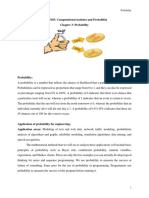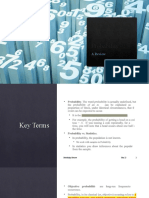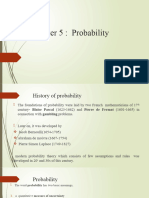Introduction to Probability
Introduction: Probability is the study of uncertainty and randomness. It allows us to quantify how
likely events are to occur, helping in decision-making under uncertain conditions. Applications
range from games of chance to weather forecasting and machine learning.
Chapter 1: Basic Concepts 1.1 Experiment, Sample Space, and Events - Experiment: Any process
with uncertain outcomes (e.g., tossing a coin). - Sample Space (S): The set of all possible
outcomes. Example: S = {Heads, Tails}. - Event: Any subset of the sample space (e.g., getting a
Head).
1.2 Classical Probability - If all outcomes are equally likely, P(E) = (number of favorable outcomes) /
(total outcomes) - Example: Probability of rolling a 3 on a fair die: P(3) = 1/6
Chapter 2: Probability Rules 2.1 Addition Rule - For mutually exclusive events: P(A or B) = P(A) +
P(B) - For general events: P(A or B) = P(A) + P(B) - P(A and B)
2.2 Multiplication Rule - For independent events: P(A and B) = P(A) * P(B) - For dependent events:
P(A and B) = P(A) * P(B|A)
2.3 Complementary Rule - P(not A) = 1 - P(A)
Chapter 3: Conditional Probability - P(A|B) = Probability of A given B has occurred = P(A and B) /
P(B) - Independent events: P(A|B) = P(A)
Worked Examples: 1. Tossing two coins, probability of getting two Heads: P(HH) = 1/4 2. Drawing a
card from a deck, probability of getting a King: P(King) = 4/52 = 1/13 3. Rolling a die, probability of
getting an even number: P(even) = 3/6 = 1/2
Applications: - Games: Predict outcomes in gambling or board games - Risk analysis: Insurance
and financial modeling - Science: Genetics probabilities, quality control, machine learning
Summary: - Understand sample space, events, and probability rules - Apply addition, multiplication,
and complementary rules - Solve basic probability problems
Exercises: 1. A die is rolled twice. What is the probability of getting a sum of 7? 2. From a deck of
52 cards, what is the probability of drawing an Ace or a Heart? 3. If two events A and B are
independent and P(A)=0.3, P(B)=0.5, find P(A and B). 4. A bag contains 3 red and 2 blue balls. One
ball is drawn. Find the probability it is not blue. 5. Tossing three coins, what is the probability of
getting exactly two Heads?






















































